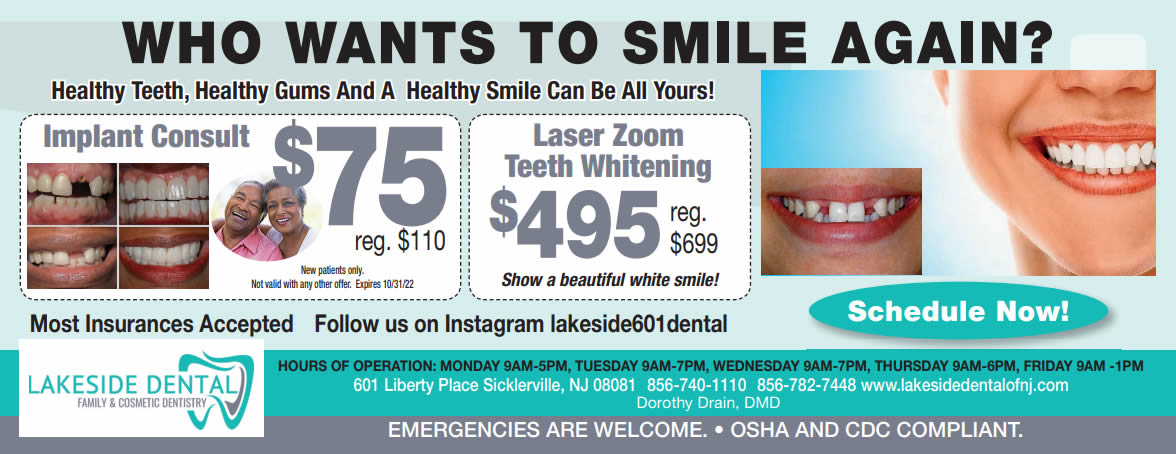
If you have lost all of your teeth or just a few, you are probably a good candidate for dentures. Dentures, also known as removable prosthodontics, are used for the dental restoration or replacement of missing or broken teeth. You may want to consider dentures if any of the following apply to your situation:
- You have very few remaining teeth and they are in poor condition.
- You have suffered bone loss in your mouth so severe it precludes you from considering dental implants.
- You have advanced gum disease that has resulted in the loss of multiple teeth.
- You have lost many teeth, and your remaining teeth are suffering from decay and receding gums.
- You are committed to practicing excellent oral hygiene to take good care of your dentures.
You may not be a good candidate for dentures if any of the following apply:
- You are a young patient whose jawbone has not fully developed.
- You grind or clench your teeth.
- You have a sensitive gag reflex.
- You are a smoker.
If you feel you are a good candidate for dentures, your dentist will evaluate the health of your teeth and gums and determine if full or partial dentures are the best choice for you. There are many factors to consider when having dentures placed, and your dental professional can help you make a decision that fits your needs and lifestyle. If you wish to regain oral functionality and improve your smile, dentures may be your answer to once again enjoying a full set of beautiful, natural-looking teeth.
Do not wait any longer. Book your appointment now and achieve the smile you have always wanted. Dr. Drain is accepting new patients from Sicklerville and the surrounding area.

Most dental professionals recommend removing third molars, or wisdom teeth, during early adulthood, ideally before they are fully formed and rooted into the jaw. This typically involves extraction between the ages of 17 and 25. Delaying the removal of wisdom teeth can lead to significant risks and complications.
Wisdom teeth that are left in place can lead to the following risks:
- Impaction: Wisdom teeth may not have enough space to grow, causing pain and potential damage to surrounding teeth and tissues.
- Tooth decay: Wisdom teeth are difficult to clean, making them prone to decay.
- Infection: Bacteria can get trapped in the eruption site, causing infection.
- Cysts and tumors: Severely impacted wisdom teeth can lead to the growth of cysts or even tumors.
For patients needing wisdom teeth removal later in life, complications can include:
- More complicated surgery: Deeply rooted or impacted wisdom teeth may require more complex surgical procedures, leading to longer recovery times.
- Nerve damage: The roots of wisdom teeth may be close to nerves affecting the lower lip, and surgery could potentially damage these nerves, causing permanent sensation loss.
If you or your young adult have emerging wisdom teeth, it’s important to schedule a consultation with your dentist to assess whether and when extraction is necessary. While not all patients need wisdom teeth removed, extracting them during eruption can help avoid many future dental issues. Early removal typically leads to quicker recovery times and fewer complications.
Do you live in Sicklerville or the surrounding area? Our team is ready to help you achieve your smile goals. Schedule your appointment today.

For those who feel self-conscious about showing their teeth when smiling, dental veneers offer an excellent solution to enhance self-confidence and quickly achieve a radiant smile. No longer reserved for the wealthy or famous, the magic of transforming smiles with veneers is now accessible to everyone.
Veneers are thin, custom-made shells that cover the front surfaces of your teeth, concealing imperfections. These veneers are designed to look incredibly natural and aesthetically pleasing. They effectively mask issues such as staining, chips, crookedness, or misshapen teeth. The two most common types of materials used for veneers are composite and porcelain, and here’s what you need to know about each:
Composite Veneers:
- Opaque finish that can be challenging to match the natural enamel color
- Typically lasts for about two years or less
- Prone to staining due to its porous nature
- Requires consistent care to maintain their appearance
- Generally more affordable than porcelain veneers
Porcelain Veneers:
- Opaque finish that mimics the natural look and texture of real teeth
- Can last anywhere from five to ten years
- Resistant to staining
- Requires good dental hygiene to maintain optimal results
Regardless of which type of veneer you choose, the decision to restore your smile with veneers is likely to bring lasting satisfaction. People will hardly notice the veneers, and your secret of having crooked, stained, or chipped teeth will be safely hidden, thanks to the advanced technology of dental veneers.
Take the first step towards a confident smile. Contact our Sicklerville dental office to schedule your consultation!

There are a number of reasons that dentists or oral surgeons recommend surgery, but facial injuries are probably the most unexpected and alarming cause. Maxillofacial injury, or facial trauma, refers to any injury to the mouth, jaw, and face. Most of these injuries result from sports, car accidents, job accidents, violence, or an accident at home. Let’s learn about oral surgery resulting from facial trauma.
Broken bones are a common type of serious facial injury. Fractures can occur in the upper or lower jaw, cheekbones, palate, and eye sockets. Injuries in these locations may affect vision and the ability to eat, talk, and breathe. Hospitalization is often required for treatment, which is similar to that for fractures in other parts of the body. The bones must be lined up and held in place to allow time to heal them in the correct position. Because casts are not possible in facial injuries, the surgeon may use wires, screws, or plates to treat fractures. Sometimes healing takes as long as six weeks or more.
Even though some facial injuries are worse than others, all of them should be taken seriously. They affect an important area of the body, so it is recommended to seek treatment from an oral surgeon to make sure you receive optimum care. Even if stitches are all that’s required, it’s best to have them performed by an oral surgeon who can place them exactly as needed to produce the best results.
It’s no surprise that the best solution for facial injuries is to prevent them in the first place. Oral surgeons suggest consistent use of mouth guards, seat belts, and masks and helmets as required. Improvements have been made to safety gear to make these items more comfortable and efficient, so there should be no excuses for not using them to protect yourself and avoid injuries that can lead to oral surgery.
Take the first step towards optimal oral hygiene. Reserve your dental appointment at our Sicklerville dental office now and experience personalized care.

Losing teeth for one reason or another is not as uncommon as you might think. Injuries and severe tooth decay are only a couple of the causes for smiles to have holes in them from missing teeth. The good news is that you don’t have to go through life with an incomplete smile. Dental implants provide one solution for replacing lost teeth.
Popularity
These restorations that involve a titanium root with an artificial tooth on top have become increasingly popular. Instead of using bridges or dentures that are known to have some hassles with them, implants are a permanent and secure solution. Once the area has healed, you can go back to your normal habits without any concerns related to the implant. They look very natural, preserve neighboring teeth, improve speech, restore the mouth’s function, and help maintain your facial features.
Candidates
Good candidates for implants have strong enough jawbones to be able to support the implant. Patients with significant bone loss may not be able to successfully maintain implants. Good oral health is helpful, as is good general health since surgery is required. Smokers and those with certain health conditions may not be recommended for dental implants.
Procedure
Once you’ve been identified as a good candidate, the first step is having the titanium rod inserted into your jawbone. It can take up to three months for it to completely fuse with your bones. Then your dentist will make an abutment to hold the implant, and a mold will be taken of your mouth so that the crown can be created. Until it is ready, a temporary crown will be placed. Finally, your crown will be placed and adjustments will be made if needed.
Maintenance
After your implant is complete, you can resume your regular lifestyle. Your normal dental hygiene routine of brushing, flossing, and checkups should be maintained for the best results.
We offer dental implants at our [Sicklerville] dental office.

There are a number of reasons people choose to get dental veneers, which are able to hide all kinds of tooth problems. These thin porcelain shells are bonded to the front surfaces of your teeth and can transform an embarrassing smile into one to fill you with pride. One of the most common reasons that many patients opt for veneers is to hide discolored teeth.
No matter what the cause for it, teeth can lose their bright white shine over time. It can be from consuming foods and drinks that tend to stain teeth, such as red wine, coffee, berries, sodas, and other culprits. Or it can be side effects from medications, including the antibiotic tetracycline which can cause severe tooth discoloration if taken during a child’s formative years. Poor oral hygiene can also contribute to yellowed teeth, as well as tobacco use. Aging in general tends to discolor teeth too.
If your teeth show the effects of staining or yellowing, and you’d like to get that healthy youthful glow back, porcelain veneers are a good option. They provide a unique advantage of never staining, so they look like new the entire time you have them. With proper care, your veneers should last for decades or even a lifetime. That means a bright, white smile that won’t deteriorate!
Another great benefit about veneers is that they provide an instant improvement to your smile. As soon as they are placed, your smile will be transformed. If you have concerns about what they will look like, many dentists are able to use computerized photo imaging technology to give you an accurate idea of what to expect. This may alleviate any hesitations about veneers being the right solution to hide your discolored teeth. Ask your dentist today about the possibility of getting veneers to improve your smile.
Are dental issues holding you back? Take control of your oral health by booking an appointment with our experienced team at our Sicklerville dental office.












